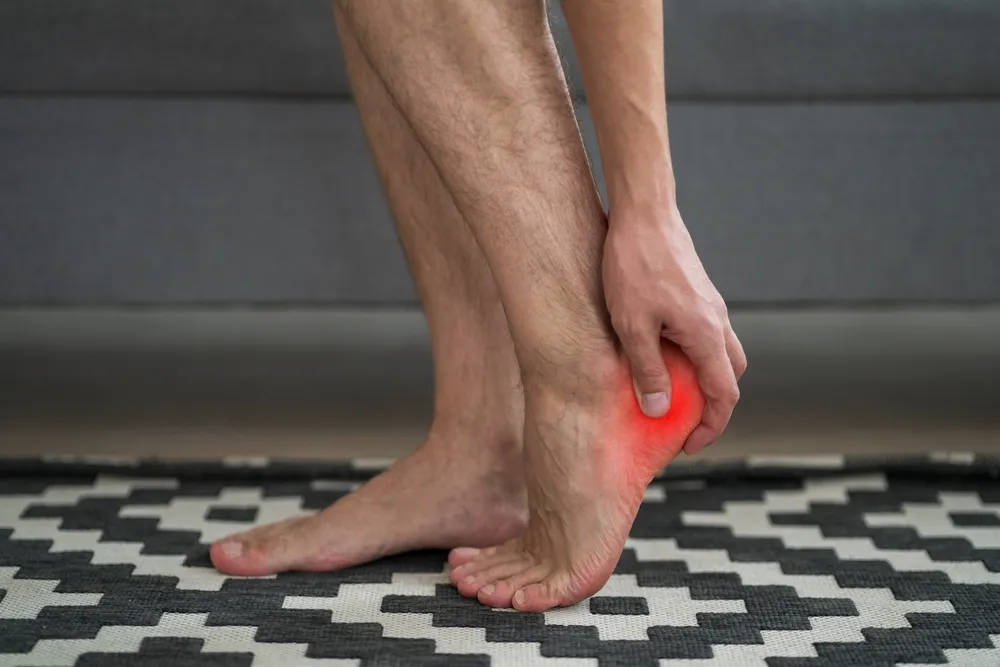Using a Massage Gun for Plantar Fasciitis
Plantar fasciitis is a common condition that causes heel pain, particularly in the morning or after long periods of inactivity. The plantar fascia is a thick band of tissue that connects the heel bone to the toes. When this band becomes inflamed or irritated, it can lead to pain and discomfort. Understanding the condition, its causes, and symptoms is crucial in finding the right treatment plan.
What is Plantar Fasciitis?

Understanding the condition
Plantar fasciitis is the inflammation of the plantar fascia, a thick band of tissue that runs across the bottom of the foot, connecting the heel bone to the toes. It is a common foot condition that affects millions of people worldwide. The pain is usually felt near the heel and is often described as a sharp, stabbing sensation.
Causes and symptoms
This condition can be caused by various factors, including repetitive strain, high-impact exercises, obesity, and improper footwear. People who spend long hours on their feet or engage in activities that put excessive stress on the heels are at a higher risk. Common symptoms of plantar fasciitis include heel pain, especially in the morning or after prolonged periods of rest, stiffness, and difficulty walking.
Diagnosis and treatment options
Diagnosing plantar fasciitis usually involves a physical examination and discussing the patient’s medical history. Imaging tests, such as X-rays or ultrasounds, may be ordered to rule out other potential causes of foot pain. Treatment options for plantar fasciitis include rest, ice therapy, stretching exercises, physical therapy, orthotic devices, and in severe cases, surgery. Massage therapy is a non-invasive treatment option that has shown promising results in managing plantar fasciitis.
How Can Massage Help with Plantar Fasciitis?
The benefits of massage therapy
Massage therapy offers a range of benefits for overall health and wellness, and it can be particularly effective in relieving foot pain caused by conditions like plantar fasciitis. It helps to improve blood circulation, reduce inflammation, relax muscles, and promote healing. Massage therapy also provides a sense of relaxation and well-being, which can have a positive impact on both physical and mental health.
How massage can relieve foot pain
Deep tissue massage, a technique commonly used in treating plantar fasciitis, targets the deeper layers of tissue to alleviate pain and promote healing. By applying pressure and friction to the affected area, massage can help to break down scar tissue, improve flexibility, and reduce tension in the muscles and fascia. This can lead to a reduction in pain and an improvement in overall foot function.
Evidence-based benefits of massage for plantar fasciitis
Several studies have demonstrated the effectiveness of massage therapy in managing plantar fasciitis. A study published in the Journal of Bodywork and Movement Therapies found that massage treatments significantly reduced heel pain and improved foot functionality in individuals with plantar fasciitis. Another study published in the International Journal of Therapeutic Massage and Bodywork concluded that massage therapy was effective in reducing pain and improving quality of life in patients with chronic plantar fasciitis.
Using a Massage Gun for Plantar Fasciitis

The role of massage guns in managing plantar fasciitis
A massage gun is a handheld device that delivers rapid, percussive strokes to the muscles and fascia. It can be a helpful tool in managing plantar fasciitis by targeting the affected area directly. The rapid vibrations and deep tissue massage provided by the massage gun can help to reduce pain and inflammation, improve blood circulation, and promote healing.
Choosing the best massage gun for plantar fasciitis
When selecting a massage gun for plantar fasciitis, it is essential to choose one that offers adjustable speed and intensity settings. This allows for personalized treatment based on individual needs and comfort levels. Look for a massage gun that is specifically designed for targeting the foot and calf muscle areas to ensure effective treatment.
Proper technique for using a massage gun on the foot
To use the massage gun for plantar fasciitis, start by applying a generous amount of lotion or massage oil to the affected area. Then, hold the massage gun perpendicular to the foot and gently glide it along the arch and heel, focusing on areas of tenderness. Use a slow, steady motion and adjust the speed and intensity of the massage gun according to your comfort level. Remember to listen to your body and stop if you experience any pain or discomfort.
How to Incorporate Massage into Your Plantar Fasciitis Treatment Plan
Combining massage with other treatment modalities
Massage therapy can be used in conjunction with other treatment modalities for plantar fasciitis, such as stretching exercises, orthotic devices, and physical therapy. The combination of different treatment approaches can enhance the effectiveness of the overall treatment plan and provide comprehensive relief from foot pain.
Recommended frequency and duration of massage sessions
The frequency and duration of massage sessions for plantar fasciitis may vary depending on individual needs and the severity of the condition. It is recommended to start with two to three sessions per week, with each session lasting approximately 15-20 minutes. As symptoms improve, the frequency of massage sessions can be gradually reduced.
Tips for self-massage at home
In addition to professional massage therapy, self-massage at home can also provide relief from plantar fasciitis symptoms. You can use your hands, a tennis ball, or a massage ball to apply pressure and massage the bottom of the foot. Remember to start gently and gradually increase the pressure as tolerated. Focus on areas of tightness and discomfort, and perform the self-massage for a few minutes each day.
The importance of consulting with a healthcare professional
While massage therapy can be beneficial for managing plantar fasciitis, it is essential to consult with a healthcare professional for an accurate diagnosis and personalized treatment plan. A healthcare professional can assess your specific condition, provide guidance on incorporating massage into your overall treatment plan, and ensure that it is safe and appropriate for your individual needs.
Long-term benefits of incorporating massage into your routine
Incorporating massage into your routine can have long-term benefits beyond just managing plantar fasciitis. Regular massage therapy can help to improve circulation, reduce muscle tension and stress, enhance flexibility, and promote overall well-being. It can also serve as a form of self-care and relaxation, contributing to a healthier and more balanced lifestyle.
Final Thoughts
Plantar fasciitis can significantly impact your daily life and overall well-being. Taking care of your feet through proper footwear, regular stretching, and incorporating massage therapy can help you stay active, mobile, and pain-free in the long run. By making small adjustments in lifestyle choices and incorporating massage therapy into your treatment plan, you can take an active role in managing plantar fasciitis and achieving long-term relief from foot pain. With the right approach and self-care, you can get back to your daily activities and enjoy a healthy, active lifestyle.




